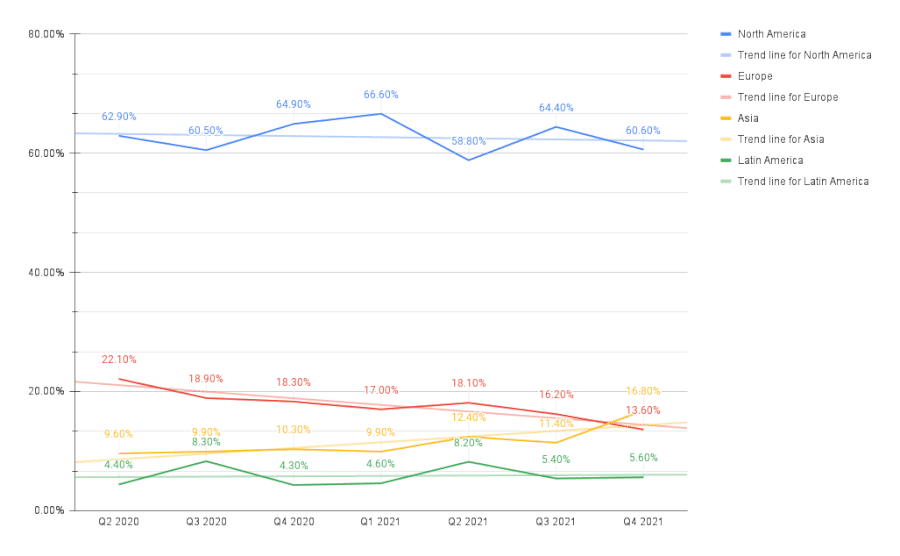
Squid Game – Picture: Netflix
Where does the most popular content on Netflix originate from? Over the past two years, it’s been predominantly from North America with European content in a close second. Likely with the help of Squid Game, Asian content is continuing to trend upwards on Netflix.
Thanks to FlixPatrol for this data who have been tracking top 10s across the world for close to two years now, they enable us to get a broad view of what’s popular on Netflix with daily top 10 lists since March 2020 when the top 10s were introduced.
From the top 10 data we can garner what’s popular on the service including what genres perform well, whether licensed content or Originals perform the best and in this instance, see where the most popular content originates from.
North American content (content from the United States, Mexico and Canada) remains the most popular content on Netflix. It’s not trending in any particular direction and we suspect will remain the most popular content for years to come.

Netflix Top 10 Preference Graph for Where Content Originates From
European content losing ground to Asian content is perhaps the most interesting trends from the above chart (and full data sheet embedded below). In Q2 2020, 22.1% of all titles in the Netflix top 10s originate from Europe but that figure is now down to 13.6% in Q4 2021. That’s a 38% drop.
Compare that to the massive rise for Asian content from 4.2% in Q1 2020 to 16.8% in Q4 2021. That is a 300% increase.
The trend comes no doubt in part thanks to an increased slate from the region. In February 2021, Netflix announced it would spend half a billion on Korean content alone. We’ve already seen some of that spending come to fruition.
K-dramas in particular dominated the Netflix top 10s with titles like Squid Game (which is now Netflix’s most-watched TV show of all time), Vincenzo, Hometown Cha-Cha-Cha, and others have helped propel the region up the list.
Netflix’s content spends in Europe continues to remain high with a 2018 report suggesting the budget has now surpassed $1 billion. It simply could mean that Asian content on Netflix is just resonating across the globe more.
Here’s that data in a table format. While we’ve included Q1 2020 here we didn’t in the graph given its incomplete data (we’re missing data from January through March).
| Q1 2020 | Q2 2020 | Q3 2020 | Q4 2020 | Q1 2021 | Q2 2021 | Q3 2021 | Q4 2021 | |
|---|---|---|---|---|---|---|---|---|
| North America | 54.6% | 62.9% | 60.5% | 64.9% | 66.6% | 58.8% | 64.4% | 60.6% |
| Europe | 37.5% | 22.1% | 18.9% | 18.3% | 17.0% | 18.1% | 16.2% | 13.6% |
| Asia | 4.2% | 9.6% | 9.9% | 10.3% | 9.9% | 12.4% | 11.4% | 16.8% |
| Latin America | 2.7% | 4.4% | 8.3% | 4.3% | 4.6% | 8.2% | 5.4% | 5.6% |
| Oceania | 0.7% | 0.1% | 0.3% | 0.2% | 0.3% | 0.4% | 0.6% | 0.5% |
| Africa | 0.3% | 0.8% | 1.4% | 1.1% | 0.4% | 1.0% | 0.5% | 0.7% |
| Other | 0.0% | 0.1% | 0.6% | 0.8% | 1.3% | 1.1% | 1.4% | 2.3% |
What do you think about these stats? Are you watching more Asian content on Netflix at the moment? Let us know in the comments.




